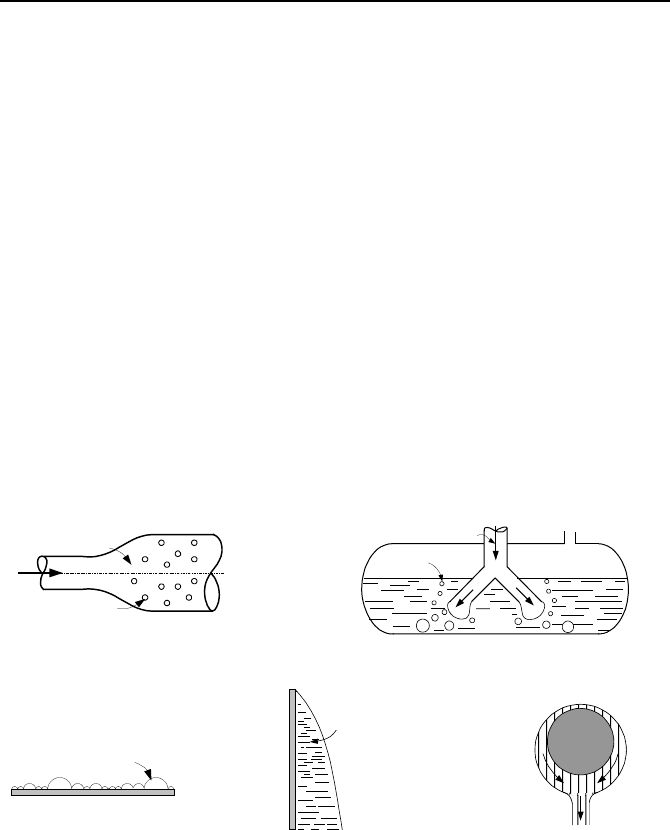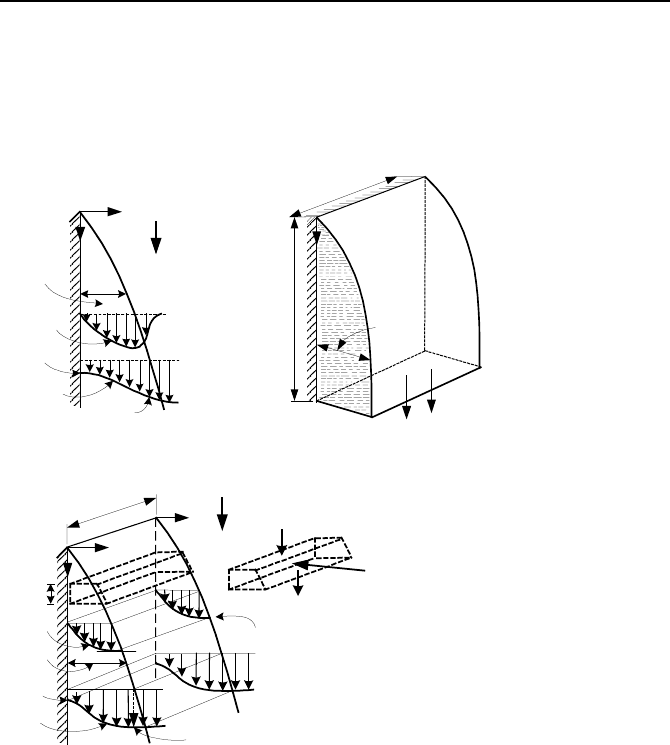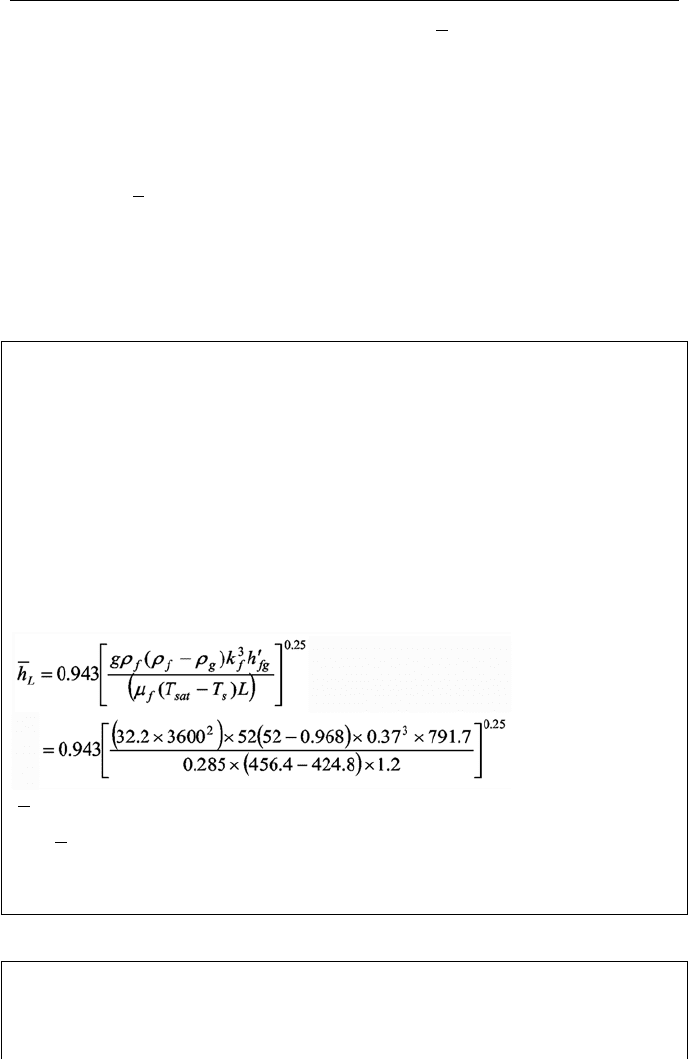Massoud M. Engineering Thermofluids: Thermodynamics, Fluid Mechanics, and Heat Transfer
Подождите немного. Документ загружается.


672 Vb. Two-Phase Flow and Heat Transfer: Boiling
)(
,1 CHFssCHF
TTCqq −−
′′
=
′′
Vb.5.10
where T
s
and T
s,CHF
are surface temperatures corresponding to q
′′
and
CHF
q
′′
, re-
spectively. Coefficient C
1
is given as a function of pressure. If P > 1200 psia,
then C
1
= 1180.8 – 0.252(P – 1200). Otherwise, C
1
= 1180.8 – 0.801(P – 1200).
The heat transfer coefficient for transition boiling is obtained by dividing q
′′
cal-
culated from Equation Vb.5.10 by (T
s
– T
sat
). The transition boiling correlation is
valid until the heat flux calculated from Equation Vb.5.10 becomes smaller than
the heat flux corresponding to stable film flow boiling. More recently, Cheng
suggested a similar correlation:
[]
n
satCHFssatsCHF
TTTTqq )/()(
,
−−
′′
=
′′
Vb.5.11
where for low-pressure n = -1.25. Bjornard tied the transition heat flux to CHF
and MSFB:
MSFBCHF
qCqCq
′′
−+
′′
=
′′
)1(
11
Vb.5.12
where coefficient C
1
itself is tied to the T
CHF
and T
MSFB
as C
1
= [(T
MSFB
– T
s
)/(T
MSFB
– T
CHF
)]
2
.
5.6. Film Flow Boiling
The heat transfer coefficient in stable film flow boiling may be calculated from the
correlation suggested by Dougal-Rohsenow. This correlation is a Reynolds num-
ber-modified Dittus-Boelter correlation given as:
[]
4.0
8.0
Pr)v/vRe()/023.0(
g
Dkh = Vb.5.14
The appearance of v/v
g
makes Equation Vb.5.14 also applicable to the flow of sin-
gle-phase vapor.
QUESTIONS
– What are the three conditions for bubble equilibrium? Why should the liquid
be superheated?
– What is the difference between boiling by a heated surface and boiling by re-
ducing the pressure of a saturated liquid? Why is Equation Vb.2.1 not suffi-
cient to predict the degree of superheat required for nucleation?
– A heated plate is immersed in water. The temperature profiles of the thermal
sub-layer and bubble as given by the Clausius-Clapeyron relation do not inter-
sect. What should be done to start nucleation?
– Can we construct the entire boiling curve in a power-controlled process?
– In which medium (liquid or vapor) is the contact angle measured?
– Is it correct to say that the heat flux in nucleate pool boiling is a function of sur-
face conditions, surface superheat, and pressure?

Questions and Problems 673
– Consider two electrically heated stainless steel surfaces. One surface is me-
chanically polished and the other is ground and polished. Both surfaces are
maintained at the same temperature and boiling with the same liquid is taking
place at the same pressure. Which surface requires higher power?
– Since
ρ
, h
fg
, T
sat
, and
σ
are functions of pressure, can we conclude that q
′′
in
pool nucleate boiling increases as pressure increases?
– Why does surface aging decrease the rate of surface heat flux?
– Explain the effect of non-condensable gases on boiling and on condensation
heat transfer.
– Since g appears in boiling correlations, can we conclude that heat flux is a func-
tion of gravity?
– Why is boiling heat flux not affected by surface roughness in the film boiling
mode?
– What is the difference between dryout CHF and DNB CHF? In what type reac-
tor is DNB a concern?
– What effect does mass flux have on critical heat flux?
– Can transition boiling be experienced in heat flux controlled boiling?
– Is the Chen correlation for heat transfer coefficient applicable to post-CHF heat
transfer?
– In a uniformly heated tube, at what location is CHF most likely to occur?
PROBLEMS
1. We noticed that the required degree of superheat depends both on the surface
condition (the size of the nucleation sites) and the type of liquid (wetting versus
non-wetting). Regarding the type of liquid, we want to examine two extreme
cases. Find the required degree of superheat for nucleation for liquids that com-
pletely wet the surface (
φ
= 0
o
). Similarly, find the degree of superheat for com-
pletely non-wetting liquids (
φ
= 180
o
). [Ans.: For
φ
= 0, there is no nucleation.
For
φ
= 180, no superheat is required].
2. Similar to the bubble growth in a conical cavity, the bubble growth in a cylin-
drical cavity is shown in the figure. Verify the accuracy of the plot of the inverse
of bubble radius (1/r) versus bubble volume.
φ
< 90
o
b
b'
c
d
e
b
b' c
d
e
1/r
b
V
b

674 Vb. Two-Phase Flow and Heat Transfer: Boiling
3. Find the degree of superheat (T
s
– T
sat
) for a horizontal flat plate in water at at-
mospheric pressure needed to cause nucleation if cavity sizes of 5
µ
m are present
in the heated surface.
4. Use Equation Vb.2.4 to find the minimum degree of superheat for the onset of
nucleate boiling.
5. Use Equation Vb.2.1 to compare the required degree of superheat for water and
for sodium nucleation. [Hint:
σ
sodium
>
σ
water
].
6. A polished copper plate 0.05 m
2
in area is placed in water and electrically
heated to 116 C. Find the rate of evaporation. [Ans.:
q
′′
= 0.587E6 W/m
2
, =m
46.86 kg/h, and h = 36,688 W/m
2
·C].
7. A pan made of stainless steel contains water at atmospheric pressure. The pan
diameter is 25 cm and its surface is mechanically polished. The pan is now heated
while its surface is maintained at 116 C. Find the surface heat flux, the boil off
(evaporation) rate, and the peak heat flux. [Ans.:
q
′′
= 5.6E5 W/m
2
, =m
44
kg/h, and
CHF
q
′′
= 1.27 MW/m
2
. Note that the operating heat flux is less than half
of the peak heat flux hence, a safety factor of 1.27E6/0.56E6 = 2.26].
8. A platinum wire having a diameter of 1.27 mm is used to boil water at atmos-
pheric pressure. The surface superheat is 650 C. Find h and
q
′′
. [Ans.: h
conv
=
298 W/m
2
·C, h
total
= 368 W/m
2
·C, 240 kW/m
2
]
9. Use the Rohsenow pool boiling correlation to find the heat flux at which in-
cipient boiling occurs. The natural convection heat flux is given as
25.1
63.2 Tq ∆=
′′
kW/m
2
. Use water (C
sf
= 0.0132) at P = 3.5 MPa. [Ans.:
4.2 kW/m
2
].
10. A pool of liquid nitrogen at atmospheric pressure is used to cool an electronic
device that generates a constant amount of heat. As the temperature of the device
is unacceptably high, the following measures are proposed to lower the tempera-
ture:
a) substitute liquid hydrogen (a lower boiling point) for nitrogen
b) increase the heat transfer area by a factor of three
c) do both a and b.
Use the given data and recommend the course of action that should be followed.
Data: (T
Wall
)
Initial
= 1000 R, q
′′
= 150,000 Btu/h·ft
2
, properties in British Units
are:
T
sat
h
fg
ρ
v
ρ
l
σ
k
v
k
l
µ
v
µ
l
H
2
37 190 0.084 4.50 1.45E-4 0.0080 0.067 0.0027 0.032
N
2
140 86 0.280 50.0 5.90E-4 0.0034 0.088 0.0130 0.440
where T
sat
(R), h
fg
(Btu/lbm),
ρ
(lbm/ft
3
),
σ
(lbf/h), k (Btu/h·ft·F),
µ
(lbm/h·ft).

Questions and Problems 675
You may use the Rohsenow and Griffith correlation for critical heat flux:
()
6.0
/143
vfgvCHF
hq
ρρρ
∆=
′′
.
11. A tank of water at atmospheric pressure is heated by an electric resistance
heater. The voltage to the heater is held constant at 1000 V. Over the range of in-
terest, the resistance of the heater in British unites can be expressed as R(T) = –
21.07 + 0.11585T where T is in F and R is in ohms. The water is heated to satura-
tion. At some location the heater temperature reaches 250 F, at which point CHF
occurs, and the boiling regime changes to film boiling. Find the heat flux and the
heater temperature at which the heater will be operating after this occurs. Data:
d
Heater
= 0.25 in, A
Heater
= 1 ft
2
. Neglect radiation effects.
12. Water at a rate of 1 lbm/s flows in a vertical heated tube (d = 1.5 in). System
pressure is 1250 psia. Find heat flux at a point where steam quality is 15% and
surface superheat is 12 F. [Ans.:
q
′′
= 108 kW/m
2
]
13. Water flows at a rate of 0.1 kg/s in a tube with a diameter of 250 mm. The
tube is heated uniformly at a rate of 135 kW/m
2
. Find the wall temperature at a
location where T
sat
= 180 C and x = 25%. [Ans.: T
s
= 188 C]
14. Consider the case of liquid flow in a uniformly heated channel. Initially, heat
flux is so low that it only increases the liquid sensible heat. We then start to in-
crease heat flux until water starts to boil. We keep increasing heat flux until even-
tually we attain a specific value for heat flux at which the tube first experiences
CHF. Under this condition at what point does CHF first occur?
15. A test tube for boiling water has a diameter of 25 mm. Water at a rate of 1000
kg/h enters the uniformly heated tube. If pressure is 7.5 MPa, find the heat trans-
fer coefficient and heat flux at a location where mixture quality is 0.25.
∆T
sat
= 10
C. [h
c
= 18,193 W/m·K, h
n
= 6,669 W/m·K, q
′′
= 249 kW/m
2
]
16. Water at a rate of 0.25 lbm/s flows in a vertical heated tube having a diameter
of 0.5 inches. Pressure in the tube is 900 psia. Find the heat flux at a point where
the mixture enthalpy is 640 Btu/lbm and the surface superheat is 6 F. [Ans.:
q
′′
=
97.6 kW/m
2
].
17. Two simple correlations for nucleate flow boiling (subcooled and saturated)
of water at 500 psia
≤ P ≤ 1000 psia are given by Jens-Lottes and by Thom-1966.
These correlations in British units are:
Jens-Lottes:
44
60/)900/4(Exp6E.1/
sat
TPq ∆=
′′
Thom:
42
72/)1260/2(Exp6E.1/
sat
TPq ∆=
′′
where q
′′
is in Btu/hr·ft
2
, P is in psia, and T is in F. These correlations in SI units
become:
Jens-Lottes:
44
25/)2.6/4(Exp6E.1/
sat
TPq ∆=
′′
Thom:
42
7.22/)7.8/2(Exp6E.1/
sat
TPq ∆=
′′

676 Vb. Two-Phase Flow and Heat Transfer: Boiling
where
q
′′
is in W/m
2
, P is in MPa, and T is in C. Use these correlations to com-
pare the results with the Chen correlation for P = 800 psia,
∆T
sat
= 10 F, and steam
quality equal to 0.1.
18. In flow boiling, we often need to find the surface temperature and its location
at which subcooled boiling begins. Although such local temperature for the in-
cipience of subcooled boiling is not a single fixed temperature, we can estimate its
value from the following relation:
T
SB
= T
sat
+ (∆T
sat
)
J-L
– )/( hq
′′
where (∆T
sat
)
J-L
is found from the Jens-Lottes correlation (see Problem 9). Find
the location and value of the surface temperature for the following case:
Water enters a heated pipe of 0.7 in diameter at T = 525 F, P = 1000 psia, and
V = 8 ft/s. Surface heat flux is uniform at a rate of 1000 Btu/h·ft
2
·F. [Ans.:
(T
s
)
incipient boiling
= 547.8 F].

1. Definition of Condensation Heat Transfer Terms 677
Vc
.
. Condensation
Similar to boiling, condensation is another mode of heat transfer, which is associ-
ated with a phase change. Thus for constant system pressure, heat transfer takes
place at constant fluid temperature. While boiling requires heat addition, in con-
densation, heat should be removed so that the process can take place. Such heat
removal may be accomplished by employing a coolant or by transferring heat to a
solid. Condensers are important components of steam power plants, refrigerators,
and chemical plants. We begin this chapter with the definition of terms pertinent
to condensation heat transfer.
1. Definition of Condensation Heat Transfer Terms
Sensible energy (c
p
∆T) refers to the energy transfer due to the change in tem-
perature.
Latent energy (h
fg
) refers to the heat of vaporization, a process during which
change of phase takes place at constant temperature. The latent energy is also
known as latent heat.
Condensation is a process during which vapor changes phase and becomes
liquid if vapor temperature is reduced to below the saturation temperature. If va-
por also includes noncondensable gases, the saturation temperature corresponds to
the condensable gas partial pressure. The condensable gas we consider in this
chapter is steam. Modes of condensation are described below and shown in Fig-
ure Vc.1.1 (a) through (e).
Homogenous condensation is a mode of condensation, which occurs within
the vapor field, where vapor forms tiny droplets of liquid suspended in the bulk of
the vapor to form a fog (Figure a). At the formation, the drops are very small and
fall so slowly that they can be considered suspended in the bulk vapor. As the
concentration of these drops increases, they combine to form larger drops, falling
as rain (rainout). If the vapor also contains gases, the fog is generated when the
bulk vapor becomes supersaturated (relative humidity > 100%). That is to say that
the vapor temperature drops below the saturation temperature at the steam partial
pressure or the steam pressure is greater than the saturation pressure at the vapor
temperature. A similar phenomenon, but for a liquid, is flashing, which occurs
when the liquid temperature is above the saturation temperature at the total pres-
sure.
Direct contact condensation is a mode of condensation where vapor is con-
densed directly on colder liquid. Examples for such mode of condensation include
quench-tank of a PWR (Figure b) and the suppression pool of a BWR. Another
example includes condensation of steam on the spray droplets.
Heterogeneous condensation occurs on a cooler surface (Figures c, d, and e).
Heterogeneous condensation is the basis for the operation of condensers. During

678 Vc. Two-Phase Flow and Heat Transfer: Condensation
the condensation process, the latent heat associated with the phase change is trans-
ferred to the cooler surface.
Dropwise condensation is a type of heterogeneous condensation (Figure c)
where drops randomly appear on a cooler surface placed in the bulk vapor. This
generally happens if the surface is not clean or the liquid does not wet the surface.
Rate of heat transfer in dropwise condensation is very high due to the high expo-
sure of surface area to the vapor. However, the tiny drops would eventually join,
reducing exposed surface area for condensation. Liquid wet-ability is discussed in
Chapter Vb.
Film condensation occurs when the liquid, which is formed from the conden-
sation of vapor, wets a clean and uncontaminated cooler surface, blanketing it with
a smooth film. In vertical plates, the thickness of the film increases as the conden-
sate flows downward (Figures d and e). Appearance of the film on the surface re-
duces the effectiveness of condensation heat transfer, due to the temperature gra-
dient across the film and the associated thermal resistance of the film. In this
chapter, we consider only film condensation.
Jakob number, after Maxim Jakob, is the ratio of sensible heat to the latent
heat, Ja = c
p
∆T/h
fg
.
Bulk Vapor
Fog
Vapor
Pool
Bubble
(a) (b)
Bulk
Vapor
Drop
Bulk
Vapor
Condensate
Film
(c) (d) (e)
Figure Vc.1.1. Various modes of condensation
2. Analytical Solution
To find an analytical solution for the heat transfer coefficient in condensation, we
consider the formation of a film of condensate on the cold surface of a vertical
plate placed in a vapor. The vapor generally includes noncondensable gases. As
shown in Figures Vc.2.1.(a and b) , the film thickness increases as liquid flows

2. Analytical Solution 679
down since more vapor condenses on the film. Liquid velocity is zero at the wall,
increasing to its maximum value at the edge of the boundary layer. Liquid tem-
perature approaches surface temperature near the wall and increases to saturation
temperature at the edge of the boundary layer. Nusselt’s derivation for film con-
densation now follows.
T
s
T
sat
δ
y
x
T(y)
V
x
(y)
g
G
T
f
Liquid
Vapor
δ
L
b
x
(a) (b)
T
s
T
sat
0/)į( =∂∂ yV
x
δ
y
x
dx
b
m
mdm
+
md
T(y)
V
x
(y)
g
G
(c)
Figure Vc.2.1. (a) Film of condensate as boundary layer and (b) Nusselt model of the
condesate film
2.1. Nusselt Derivation of Film Condensation
To be able to derive an analytical solution, several simplifying assumptions are
made, per Nusselt. First we assume that vapor does not contain any noncon-
densable gas. Second, we assume that the flow of the film is laminar with thermal
properties independent of temperature. Finally, we assume the shear stress at the
edge of the boundary layer is negligible (
∂
u(δ)/
∂
y = 0) and temperature profile in
the film is linear. The governing equation for the hydrodynamic boundary layer is
Equation IIIa.3.20-1, which reduces to:

680 Vc. Two-Phase Flow and Heat Transfer: Condensation
X
y
V
v
x
P
x
ρρ
11
0
2
2
+
∂
∂
+
∂
∂
−=
Vc.2.1
where the body force in the film is now X =
ρ
f
g and the pressure gradient is dP/dx
=
ρ
g
g. Substituting in Equation Vc.2.1, yields:
fgf
x
g
y
V
µρρ
/)(
2
2
−−=
∂
∂
Vc.2.2
Integrating Equation Vc.2.2 and using the boundary conditions of V
x
(0) = 0 and
∂
V
x
(δ)/
∂
y = 0 we find:
»
»
¼
º
«
«
¬
ª
¸
¹
·
¨
©
§
−
−
=
2
f
2
į2
1
į
į)(
)(
yy
g
yV
gf
x
µ
ρρ
Vc.2.3
Note that V
x
is also a function of x since V
x
= f[δ(x)]. Having the velocity profile,
mass flow rate is:
³
−==
)(į
0
3
)3/(į)()()(
x
fgffx
bgbdyyVxm
µρρρρ
Vc.2.4
Both V
x
and m
are functions of δ, itself an unknown. To find δ, we use an energy
balance for the control volume of Figure Vc.2.1. At steady state, the energy enter-
ing the control volume (d
m
h
fg
) is equal to the energy leaving the control volume
and entering the colder surface, d
Q
= k
f
(bdx)(T
sat
– T
s
)/δ. Setting these equal and
using Equation Vc.2.4, we find that [
fgff
bg
µρρρ
/į)(
2
− ]h
fg
dδ/dx =
k
f
(bdx)(T
sat
– T
s
)/δ. So that δ becomes:
25.0
)(
)(4
)(į
¸
¸
¹
·
¨
¨
©
§
−
−
=
fggff
ssatff
hg
xTTk
x
ρρρ
µ
Vc.2.5
Having δ, we can find both V
x
and m
as explicit functions of x. Since h = k
f
/δ and
Nu = hL/k
f
, we then have both of these parameters also as functions of x. Integrat-
ing from x to L, we can find
h and Nu :
25.0
3
)(
)(
943.0
¸
¸
¹
·
¨
¨
©
§
−
′
−
=
LTT
hkg
h
ssatf
fgfgff
L
µ
ρρρ
Vc.2.6
Note that in Equation Vc.2.6, we replaced h
fg
by
fg
h
′
= h
fg
(1 + 0.68Ja), per Roh-
senow’s recommendation. This is to account for two effects: cooling of the film
below the saturation temperature and the non-linear temperature profile in the

2. Analytical Solution 681
film. Total rate of heat transfer to the plate is )(
ssatL
TTAhQ −=
and total rate
of condensate produced is
fg
hQm
′
= /
. To determine a condensation Reynolds
number, we use Equation III.6.3,
)/(4Re Dm
π
µ
= , which is appropriate for con-
densation on a vertical cylinder. For a flat plate we have
bD ≡
π
hence,
)/(4Re bm
µ
= . Substituting for m
in term of Q
, we obtain the Reynolds num-
ber as Re
L
= 4
L
h L(T
sat
– T
s
)/(h
fg
µ
f
) where L is the plate length. Flow is laminar if
Re
L
< 30. For sufficiently large vertical plates the flow may become turbulent.
For fully turbulent flow Re > 1800 and in the range of 30 < Re < 1800, the con-
densate film becomes wavy and hence, referred to as the wavy laminar region.
Example Vc.2.1. A vertical flat plate 1.2 ft long and 2 ft wide is maintained at
424.8 F and exposed to saturated steam at 450 psia. Find the total rate of heat
transfer to the plate and the condensate mass flow rate.
Solution: We first find T
sat
(450 psia) = 456.4 F then T
film
= (456.4 + 424.8)/2 =
440.6 F to find the following:
For steam at T
sat
= 456.4 F: h
fg
= 768.2 Btu/lbm and
ρ
v
= 0.968 lbm/ft
3
For water at T
film
= 440.6 F: k
f
= 0.37 Btu/ft·h·F,
µ
f
= 0.285 lbm/ft·h,
ρ
f
= 52 lbm/ft
3
, c
pf
= 1.1 Btu/lbm·F
Since T
s
<< T
sat
we need to find
fg
h
′
= h
fg
(1 + 0.68Ja)
Ja = 1.1 × (456.4 – 424.8)/768.2 = 0.045. Thus,
fg
h
′
= 791.7 Btu/lbm
L
h = 1342.6 Btu/ft
2
·h·F
)(
ssatL
TTAhQ −=
= 1342.6 × (1.2 × 2) × (456.4 - 424.8) = 101,823 Btu/h.
fg
hQm
′
=
/
= 101,823/791.7 = 0.036 lbm/s.
Example Vc.2.2. A steel plate 1/8 in. thick with L = 10 ft is placed in saturated
steam at 1 atm. At time zero, T
s0
= 200 F. Find the time when T
s
= T
sat
. For steel,
ρ
= 488 lbm/ft
3
, c
p
= 0.1 Btu/lbm·F, and k = 26.5 Btu/ft·h·F. For steam,
ρ
f
= 59.8
lbm/ft
3
,
ρ
g
= 0.04 lbm/ft
3
, and h
fg
= 970 Btu/lbm.
